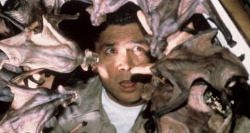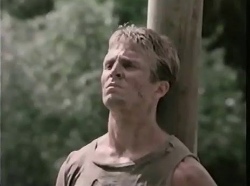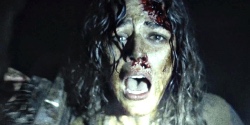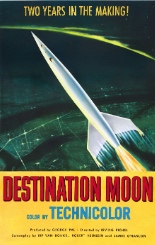
 Bats is like every other animal-attack flick that fortifies the Syfy broadcast lineup, except that this one somehow hit theaters first. It’s bad.
Bats is like every other animal-attack flick that fortifies the Syfy broadcast lineup, except that this one somehow hit theaters first. It’s bad.
Really bad.
Lou Diamond Phillips bad.
Because of a “secret government project” — a device all screenwriters employ when they wish to weasel their way out of credible explanations — a Texas desert town is overrun with thousands of lethal, hideously deformed bats. They don’t look so much like bats as they do Ghoulies with wings. Not that viewers get to see them all that well, as during scenes of supposed action, director Louis Morneau (Werewolf: The Beast Among Us) shakes the camera as violently as drunk nannies do with babies.
 Cleavage-baring Dina Meyer (Saw) has all the answers as resident bat expert Dr. Sheila Casper, while Cliffhanger’s Leon — just Leon, thanks — serves as her minority sidekick, saying lots of things that we’re supposed to find hilarious, like, “I’ve been doin’ some thinkin’ … and this shit is fucked-up!” Together, with big-belt-buckled Sheriff Kimsey (Phillips, 2000’s Supernova), they get into predictable, laughable, CGI bat attacks and grapple with predictable, laughable lines of dialogue (courtesy of eventual Skyfall scribe John Logan), including:
Cleavage-baring Dina Meyer (Saw) has all the answers as resident bat expert Dr. Sheila Casper, while Cliffhanger’s Leon — just Leon, thanks — serves as her minority sidekick, saying lots of things that we’re supposed to find hilarious, like, “I’ve been doin’ some thinkin’ … and this shit is fucked-up!” Together, with big-belt-buckled Sheriff Kimsey (Phillips, 2000’s Supernova), they get into predictable, laughable, CGI bat attacks and grapple with predictable, laughable lines of dialogue (courtesy of eventual Skyfall scribe John Logan), including:
• “Wait a minute! You’re telling me a bat did this?”
• “But bats don’t kill people. This can’t be!”
• “We’ve gotta evacuate this entire town!”
Early in the movie, we get a brief and decidedly out-of-place cutaway shot of Phillips visibly grimacing, as if the camera caught him messing his britches, and Morneau opted to keep it. I’m glad he did, because it’s a moment most priceless and thereby, unlike the bulk of Bats, engaging. I’ve been doing some thinking … and this shit is fucked-up. —Rod Lott


 Having burst into the straight-to-VHS scene with the 1983 shot-on-video “classick”
Having burst into the straight-to-VHS scene with the 1983 shot-on-video “classick” 






